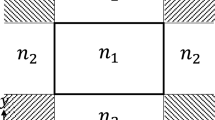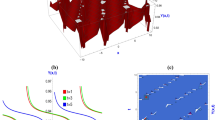Abstract
In this paper, we present a formulation of the finite-difference time-domain method for the simulation of metallic structures. The frequency dependent dielectric function of metals is approximated by a combined Drude–Lorentzian multi-pole expansion and fitting errors of only a few percent are obtained. An auxiliary differential equation technique is used to extend the standard FDTD algorithm with the dispersive material equations. The algorithm is validated by calculating reflection and transmission coefficients for thin metal layers, elliptical nano-particles and by simulating a surface plasmon resonance device. Excellent agreement between the FDTD simulations and exact theoretical results are obtained.
Similar content being viewed by others
References
Dennis J.E. Jr., Gay D.M., Welsch R.E., (1981). ACM Trans. Math. Softw. 7(3): 348
Fan G.X., Liu Q.H., (2000). IEEE T. Antenn. Propag. 48(5): 637
Gallagher D.F.G., Felici T.P., (2003). Proc. SPIE 4987: 69
Korner T.O., Fichtner W. (1997). Opt. Lett. 22: 1586
Luebbers R., Hunsberger F, Kunz K, Standler R, Schneider M., (1990). IEEE Trans. Electromagn. Compat. 32: 222
Luebbers R., Hunsberger F., (1992). IEEE T. Antenn. Propag. 40: 1297
Taflove A., (1995). Computational Electrodynamics: The Finite-Difference Time-Domain Method. Artech House, Boston, MA
Tubb A.J.C., Payne F.P, Millington R.B., Lowe C., (1997). Sensors Actuators B 41: 71
Vial A., Grimault A, Macials D, Barchiesi D, de la Chapelle M.L., (2005). Phys. Rev. B 71: 085416
Yee K.S., (1966). IEEE T. Antenn. Propag. 14(3): 302
Young J.L., Nelson R.O., (2001). IEEE Antenn. Propag. Magazine 43(1): 61
Author information
Authors and Affiliations
Corresponding author
Rights and permissions
About this article
Cite this article
Pernice, W.H.P., Payne, F.P. & Gallagher, D.F.G. An FDTD method for the simulation of dispersive metallic structures. Opt Quant Electron 38, 843–856 (2006). https://doi.org/10.1007/s11082-006-9058-0
Received:
Accepted:
Published:
Issue Date:
DOI: https://doi.org/10.1007/s11082-006-9058-0




